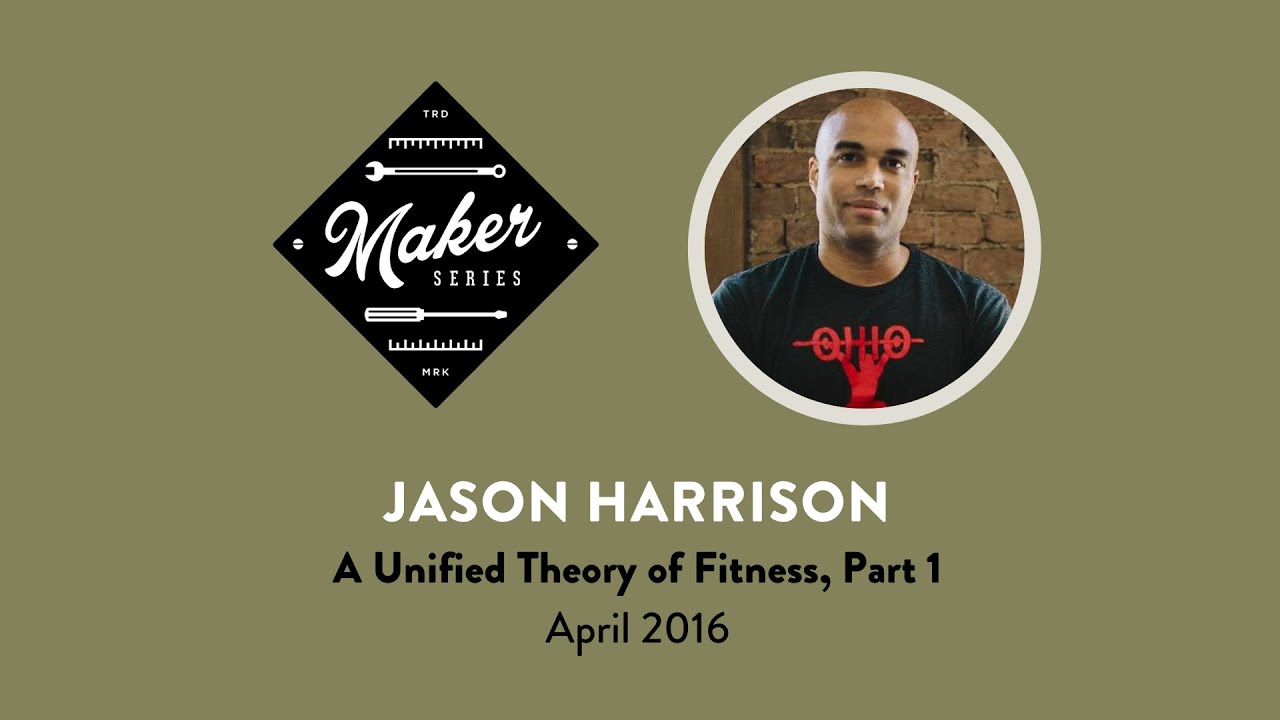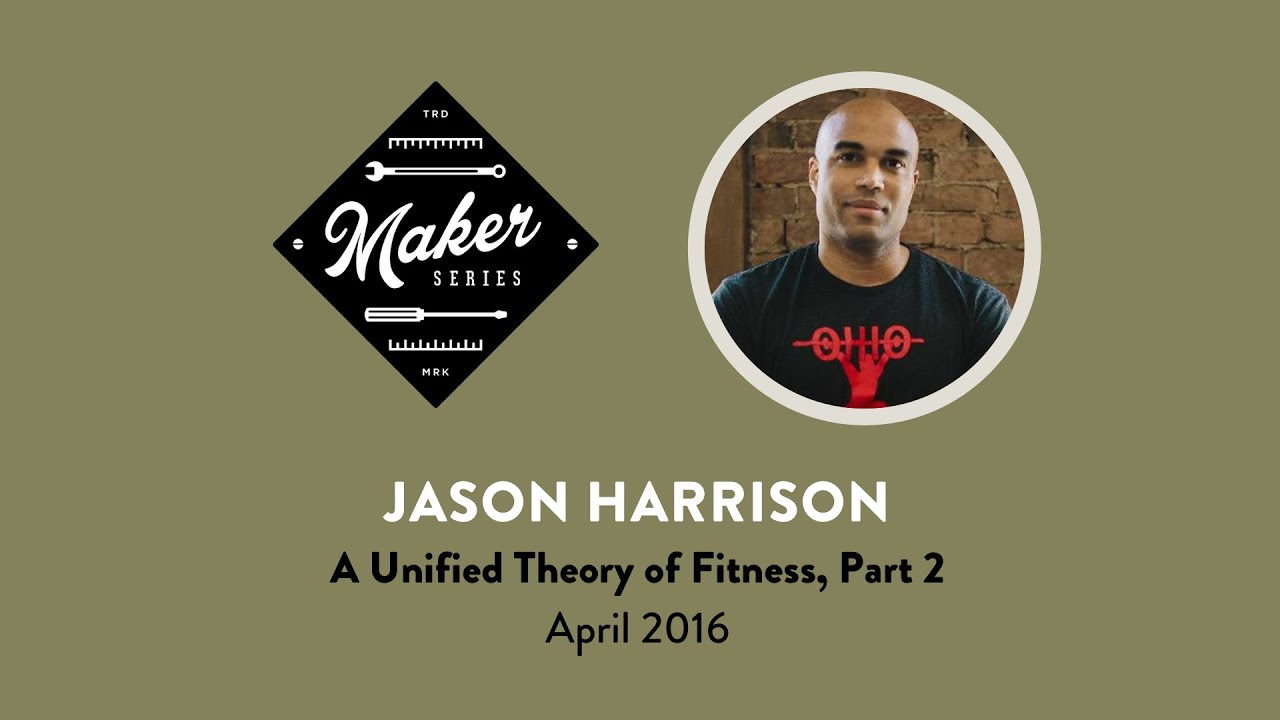As people who strive to make the web better, self-care is the most important tool in our toolkit. To do great work is to love what you’re doing and to ensure you’re healthy and well taken care of. A focus of ours at Sparkbox is to have healthy, happy, and well-adjusted employees. In line with this endeavor, the most recent Maker Series focused on how we, as people of the web, can better incorporate fitness into our already hectic schedules. We brought in personal trainer, wellness coach, and founder of Present Tense Fitness, Jason Harrison, to talk about fitness as a holistic lifestyle choice. In his workshop, A Unified Theory of Fitness, Jason walked us through the foundations of fitness and explored ways in which we can start adopting healthy habits and practices in our personal lives.
“The pursuit of strength is the keystone habit that can have exponential benefits across your entire life.” —Jason
The Elementary Foundations of Fitness
Sleep and nutrition are the two major pillars of fitness that form the foundation of a healthy lifestyle. The correlation between sleep and nutrition is simple: the less you sleep, the worse you eat. Despite this, Jason stressed in his workshop that sleep still remains the most underrated factor in the fitness world. Fitness is mistakenly so conflated with working out that we often compromise on sleep so we have enough time to squeeze in a regular workout in our already hectic lifestyles. Though caffeine keeps the lethargy at bay, we can’t escape the adverse health effects that manifest from chronic lack of sleep. Sleep deprivation can also be the defining factor between successfully attaining our superficial fitness goals or not.
Sleep
The key to understanding the relationship between sleep and nutrition is understanding the hormonal changes your body goes through on little sleep. Cortisol, leptin, and ghrelin are three hormones most significantly tied to your appetite and how your body processes food. Cortisol is the primary “stress hormone” that enhances your body’s use of glucose and curbs non-essential functions in fight and flight situations. Leptin is the “starvation hormone”—it regulates your body’s energy storage and suppresses hunger. Ghrelin is the “hunger hormone” that increases appetite. All three hormones are compromised when we lack sleep. Cortisol, leptin, and ghrelin levels in the body become elevated such that we tend to feel hungrier and our body’s ability to uptake amino acids for muscle building is significantly inhibited.
Better Sleep Habits
Getting a good night’s rest is deceivably easy. When it comes to sleeping better, a strict routine is your friend. Sleeping at the same time every day reinforces a good sleep habit that further promotes better sleep. It also helps to have a pavlovian ritual you do every night before bed, like reading a book or wiping down your counters—something that automatically puts you in the sleep mindset. This eases the transition between waking and sleeping and removes the agony that comes with trying to force yourself to sleep. If you’re still finding difficulty sleeping, Jason advises doing a gratitude exercise that helps elevate endorphin levels and calm the mind. This can be done in the form of prayer (if you’re religiously inclined) or by a simple listing of things that you feel grateful for from that day—the more specific the gratitudes, the better (i.e. I’m so grateful for having good friends to kick back with after a difficult day at work).
Nutrition
Improving nutrition is a matter of diligent process, not a “90-day cleanse.” If we look at the statistics of those who binge post “30-day lean diet” or those who “cheat” while trying to stick to their diet of water and celery sticks, it is clear that our understanding of nutrition and healthy eating is heavily flawed. Instead of focusing on weight loss by restricting calories, or hyper-monitoring caloric input-output (i.e. I ate a cupcake, now I have to go run it off), reframe your relationship with food. Nutrition is about consistently eating healthily and ensuring optimal success. Eating well should be a path of least resistance.
Better Eating Habits
Making radical changes to eating habits, like going on a radical diet, can contribute to rapid weight loss but doesn’t aid in long-term success. Improving your diet, in the long run, requires a deliberate shift in eating habits over time. Similar to how you would work up to a new habit, you should slowly develop healthy eating habits. Some easy practices to boost dietary nutrition include incorporating high-fiber foods, such as fruits and vegetables, at every meal. Not only do fruits and vegetables have a high-nutrient density, but they are also an automatic built-in portion control measure, and they slow down the process of turning sugar into fat so that you feel full for much longer. To take full advantage of including fruits and vegetables at each meal and use them as a means of portion control, eat them first—before anything else on your plate. Other ways to eat better are cooking most meals at home so you have more control over what you eat and eating slowly so your body has the time to register when it is really full. Precision Nutrition and MyPlate offer great guidelines and frameworks for adopting a healthier diet.
And Finally: Exercise
Exercise is probably the most commonly associated component of fitness. The key to maintaining a regular exercise regimen is enjoying a workout, whatever suits you best. Not all workouts are created equal, but one workout is not necessarily superior to another. Jason advises that, despite being too busy for a daily workout routine, you can still reap the benefits of working out if you do a weight-bearing exercise at least twice a week. He stresses that the goal of weight-bearing exercises is to move weight against gravity. To elaborate on his point, Jason demonstrated his own exercises and stressed the push-pull motion associated with each one. This can take a more traditional form like weight lifting or take the form of an activity, like yoga, pilates, or rock climbing. Regardless of what you choose, be mindful that exercise causes micro-damage, and it is as important to work rest and appropriate nutrition into your routine.
Leading a fit lifestyle is achievable. You can easily work in healthy habits despite already having a busy schedule. Jason reiterated that to be fit, routine and process are pivotal.
Block off sleep.
Ask yourself: When and how am I eating?
Ask yourself: When and how am I working out?
Schedule TV/leisure time.
Discuss calendars and schedules with your partner.
Fitness is a Public Policy Issue
In the spirit of Maker Series, which is to learn from experts through down-to-earth conversations about real-life experience, Jason threw a curveball and reminded us that the ability to maintain a fit lifestyle is a privilege. Staying healthy demands time (to work out and prepare healthy meals) and money (to buy healthy foods)—things that most of us take for granted. According to the Census Bureau, over 14.9 percent of Americans—or roughly 47 million people—live below the poverty line. A large majority of that figure consists of minorities and women. For those trying to make ends meet, time and money are hard to come by.
More often than not, it’s easier and cheaper to eat a quick meal at McDonald’s or to stock up on carb-heavy foods that keep you full faster and longer. What makes it doubly hard for those in less privileged backgrounds to keep fit is the limited access to healthy options. Low-income neighborhoods frequently struggle with access to well-stocked, full-service grocery stores and farmers’ markets. Most—especially those who lack access to reliable transportation—are forced to shop at convenience stores where options for good food are severely limited. Just last year, our own hometown of Dayton was ranked 9th in the country in terms of food hardship. The USDA claims that vehicle access is the most important determinant of whether a family can access affordable and nutritious food. Issues such as these are compounding factors that prevent communities and the people who live in them from prospering. The wellness rhetoric, unfortunately, remains one that puts the onus to stay fit on the individual. It disregards the important role that external factors—like access to grocery stores and education on eating healthy—play in influencing one’s ability to stay fit. It also fails to consider the resulting effects of stress and anxiety from financial and emotional pressures that significantly impede a healthy outlook on life.
Healthy Communities
Though fitness is largely a personal decision, our concept of fitness is structured by our surrounding contexts. For the majority to start thinking about fitness from a more holistic standpoint, the conversation around fitness needs to change from one focused on personal vanity (like getting a beach body in time for summer) to one that focuses on cultivating a holistically healthy lifestyle. With the right—healthy—mindset of what fitness truly means, we can do more to educate one another on how to realistically and sustainably implement these processes and routines. After all, a healthy community is a well-functioning, productive community.

YouTube embeds track user data for advertising purposes. You can watch the video on YouTube if you prefer not to grant consent for YouTube embeds.

YouTube embeds track user data for advertising purposes. You can watch the video on YouTube if you prefer not to grant consent for YouTube embeds.

